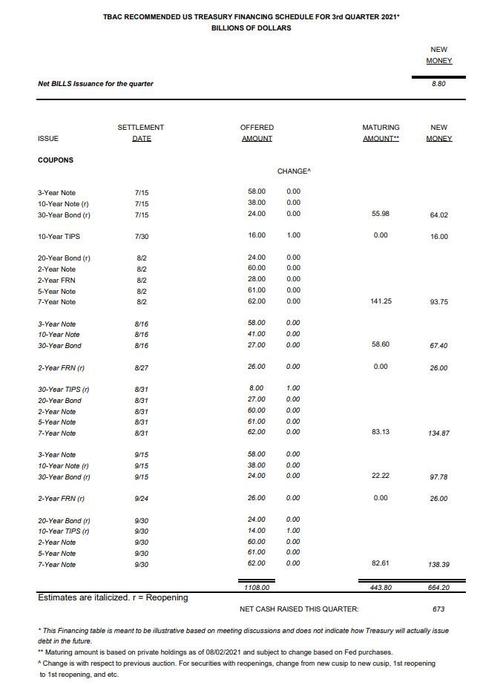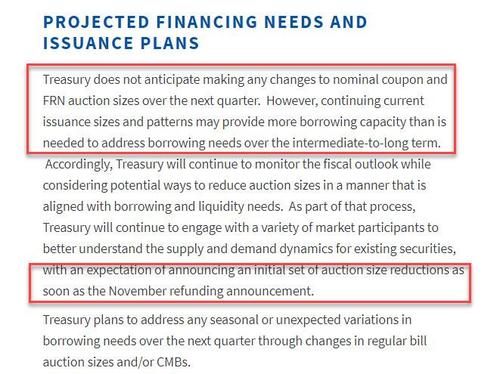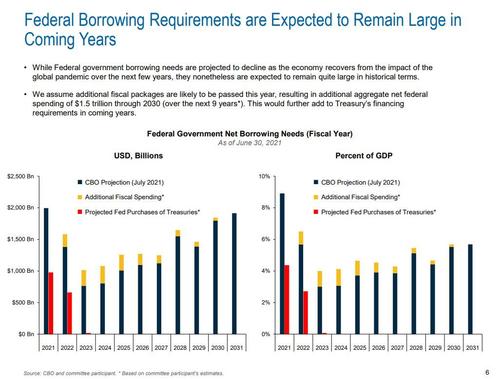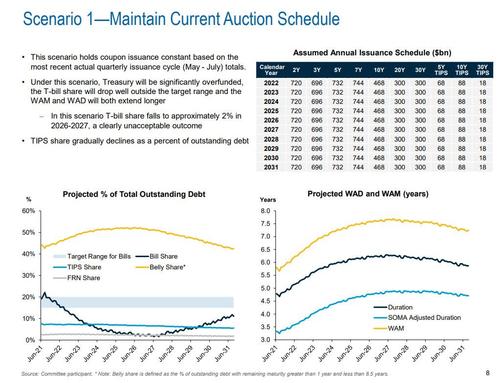Treasury To Start Reducing Bond Auction Sizes As Soon As November
Heading into today’s quarterly refunding announcement, the bond market was on edge over the (low) possibility widely discussed on sellside desks, that the Treasury could cut trim coupon auction sizes in the next few months to coincide with the Fed’s tapering as the Treasury’s funding needs have gradually emerged to be less than expected thanks to higher than expected tax revenues. In fact, according to some the drop in yields in recent weeks has been not due to the ongoing monster squeeze but due to expectations that there will be less TSY supply than demand.
So when the Treasury released its latest refunding statement (whose highlights hit about 10 mins early after some newswire broke the embargo), battered TSY bears breathed a sigh of relief because the Treasury said that contrary growing expectations, it “does not anticipate making any changes to nominal coupon and FRN auction sizes over the next quarter.” Here is the proposed treasury issuance scheduled for Q3:
However, in line with expectations, “continuing current issuance sizes and patterns may provide more borrowing capacity than is needed to address borrowing needs over the intermediate-to-long term.” And as a result, the “Treasury will continue to engage with a variety of market participants to better understand the supply and demand dynamics for existing securities, with an expectation of announcing an initial set of auction size reductions as soon as the November refunding announcement.“
In other words, shortly after the Fed’s taper announcement the Treasury will follow up with an issuance cut of its own.
So if no changes in coupon sizes, will Bill issuance at least shrink? You bet: as the Treasury added, “seasonal or unexpected variations in borrowing needs over the next quarter is to be met by changes in bill auction sizes and Cash Management Bills (CMBs).” Additionally, the Treasury will end weekly issuance of 6-week CMBs later this month:
“the amount of net new cash still being raised from coupon issuance will allow Treasury to continue gradual reductions in bills as a percent of Treasury debt outstanding, in a manner consistent with recommendations made by the Treasury Borrowing Advisory Committee (TBAC) at its November 2020 meeting. Accordingly, Treasury plans to further modify its regular cadence of CMBs. Treasury anticipates that weekly issuance of the 6-week CMBs will cease after settlement on August 19, whereas weekly issuance of the 17-week CMBs will continue at least through the end of October.
Also of note, now that the US has triggered the debt ceiling extension measures which have an impact on how much cash the Treasury can hold at the current moment ($450BN), the Treasury said that it is unsure how long extraordinary measures put in place due to the debt ceiling will last:
As Secretary Yellen recently outlined in a July 23 letter to Congress, the period of time that extraordinary measures may last is subject to considerable uncertainty due to a variety of factors, including the challenges of forecasting the payments and receipts of the U.S. government months into the future, exacerbated by the heightened uncertainty in payments and receipts related to the economic impact of the pandemic. Given this, Treasury is not able to currently provide a specific estimate of how long extraordinary measures will last.
While it was of secondary importance, the Treasury also noted that the upcoming refunding offering was in line with expectations. Specifically, the Treasury will offer $126 billion of Treasuries to refund $58.6 billion of Treasury notes and bonds maturing on August 15, 2021. This issuance will raise new cash of approximately $67.4 billion. The securities are:
- A 3-year note in the amount of $58 billion, as expected
- A 10-year note in the amount of $41 billion, as expected
- A 30-year bond in the amount of $27 billion, as expected
Going back to the Treasury’s coupon shrinkage plans, the Minutes of the latest Treasury Borrowing Advisory Committee revealed that the committee reviewed a presentation presentation about potential adjustments to coupon auction sizes in the coming years,,,
… based on the presenting member’s assessment that the current auction schedule will likely leave Treasury significantly overfunded.
It noted that several significant financing uncertainties were also highlighted by the presenting member that will require a flexible approach within the regular and predictable paradigm. The resulting share of bills outstanding, the impact on the maturity profile, and the relative persistent supply and demand dynamics at each maturity point were then discussed for each issuance size scenario.
The presenting member concluded by recommending that Treasury begin to move towards a scenario with issuance cuts across the nominal curve, but with relatively larger reductions in the 7-year and 20-year tenors, offset by smaller reductions to the 5-year, 10-year, and 30-year tenors.
The Committee then turned to its financing recommendation for the upcoming quarters. The Committee recommended that Treasury begin to reduce nominal coupon auction sizes at the November 2021 quarterly refunding and attempt to target a bill share of total marketable debt outstanding within the Committee’s past recommendation of 15 to 20 percent. However, the Committee emphasized the current level of fiscal uncertainty and the need to remain flexible if borrowing needs were to change materially.
After a discussion, the Committee further recommended that Treasury proceed in November with modestly larger reductions in the 7-year note and 20-year bond. Finally, the Committee recommended that Treasury continue to increase TIPS auction sizes at a pace consistent with the increase in gross issuance for CY2021 that was announced at the November 2020 quarterly refunding. The Committee also reaffirmed its support for Treasury to issue a floating rate note indexed to the Secured Overnight Financing Rate.
Curiously, and perhaps in connection to the recent discussions of tether, TBAC reviewed a presentation on regulatory reform options for the money market mutual fund (MMF) industry, given the stress experienced by certain types of funds during March 2020. The presenting member noted the vulnerabilities that exist for prime MMFs, highlighting common themes in several recent episodes of heightened outflows. During these events, the outflows from prime MMFs have tended to result in similarly sized and simultaneous inflows into government MMFs. The presenting member concluded by arguing that optimal reforms to address the vulnerabilities among prime MMFs should balance allowing these funds to offer attractive yields under normal market conditions while ensuring stability during periods of market stress.
The full TBAC presentation is below (pdf link)
TBACCharge1Q32021 by Zerohedge on Scribd
Tyler Durden
Wed, 08/04/2021 – 08:57
via ZeroHedge News https://ift.tt/3jjYK9z Tyler Durden



